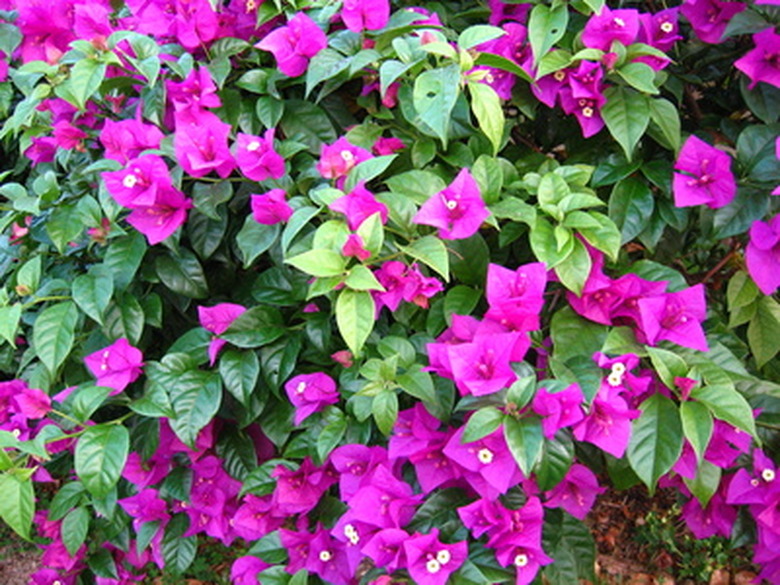Bougainvillea Vs. Torch Bougainvillea
Bougainvillea and the bougainvillea variety 'Torch Glow' are both are woody vines of tropical and subtropical origin. Placed in full sun or light shade, in a well-drained, acid soil, these plants need little maintenance and are not usually bothered by pests. In fact, they flower better under stress. Tolerant of low-water conditions, the plants are most showy in a dry and root-bound state. These flowering evergreens also produce thorns, so they are best planted away from high-traffic areas.
Size
Bougainvillea grows quickly, spreading to a height of 13 to 40 feet. The height the plant can attain depends on the amount of support it receives. Bougainvillea 'Torch Glow' grows to only 6 to 8 feet tall and 3 feet wide.
- Bougainvillea and the bougainvillea variety 'Torch Glow' are both are woody vines of tropical and subtropical origin.
- These flowering evergreens also produce thorns, so they are best planted away from high-traffic areas.
Identification
In addition to size, the main differences between the plants are the roots and flowers. Bougainvillea 'Torch Glow' has flowers at the end of branches and stems. These clusters stand erect, in a torch-like arrangement, instead of hanging in a cascade as the flowers of bougainvillea. 'Torch Glow' also has a thicker, more succulent root system, according to the patent for the variety.
Significance
Bougainvillea 'Torch Glow' can be grown in a smaller area due to its compact nature. While either version can serve as an indoor plant, the naturally restricted size of 'Torch Glow' may spare growers some degree of pruning and maintenance that may be necessary to keep bougainvillea in check. 'Torch Glow' can be used to control erosion, according to Monrovia Nursery Company.
- In addition to size, the main differences between the plants are the roots and flowers.
- Bougainvillea 'Torch Glow' can be grown in a smaller area due to its compact nature.
Considerations
Bougainvillea plants may flower in spring, summer and/or fall, depending on light levels, location and the amount of pruning. Bougainvillea bracts come in a wide variety of colors–including purple, red, pink, yellow, apricot and orange. The University of Florida Cooperative Extension Service suggests that Bougainvillea can be trained into a shrub, tree or cascading form, and dwarf varieties can serve as a ground cover. Bougainvillea 'Torch Glow' offers red- to pink-colored bracts and holds the shape of a shrub.
Warnings
Gardeners should plant both bougainvillea and bougainvillea 'Torch Glow' in containers or pots or in a warm, protected area if they are grown in zone 9. Container planting is also recommended for areas where frost is an issue or locations where the plants will need to be moved. The plants are sensitive to cold temperatures and have fragile root systems that are easily damaged. Transplanting should be performed with as little root disturbance as possible. Texas A&M University's Horticulture Department reminds gardeners that Bougainvillea can lose leaves in low-light conditions and during winter.
- Bougainvillea plants may flower in spring, summer and/or fall, depending on light levels, location and the amount of pruning.
- The University of Florida Cooperative Extension Service suggests that Bougainvillea can be trained into a shrub, tree or cascading form, and dwarf varieties can serve as a ground cover.
